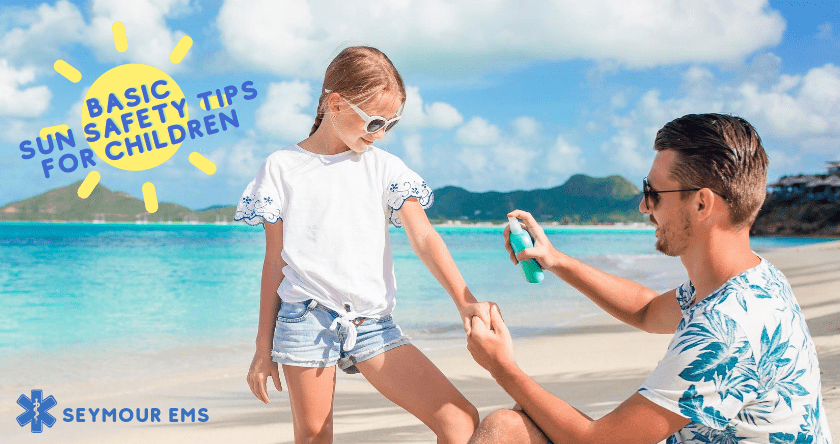Sun safety is so important when it comes to your little ones. Think about a time when you experienced sunburn. It was uncomfortable, painful, and maybe even caused you to get sick, right? While sunburn is serious in adults, it’s even more serious for children. And, lifelong exposure to the sun without following the important basics of sun safety can lead to serious problems in adulthood.
Your little one’s young, sensitive skin is something you should protect. Since they are even more vulnerable to damage caused by the sun’s rays, it’s important to protect them all year long. But, especially in summer, you should be on top of your child’s wellbeing and follow sun safety practices to avoid serious problems.
Sun Safety Tricks and Tips for Parents
As with most things in life, educating yourself on the basics of sun safety will be a huge help to make sure your entire family is safe this summer. So, an important first step is to understand the difference between UVA and UVB rays. Let’s take a look!
UVA vs. UVB Sun Rays
There are two types of sun rays we deal with when it comes to how the sun affects our skin. Ultraviolet A rays, also called UVA rays, are the sun’s rays that make our skin tan. Ultraviolet B rays, also called UVB rays, are the sun’s rays that cause our skin to burn. Although you might think UVA rays are good for you because they cause you to get that nice summer tan everyone is competing for, neither type of rays is healthy for your skin.
When it comes to sun safety, whether you become sunburnt or suntan, both are signs that your skin cells have been damaged by the sun’s radiation. In fact, both UVA and UVB rays are equal in the damage they cause to your skin and the risk they pose of leading to skin cancer. So, how do you protect the skin from these damaging rays? Let’s take a look at SPF
What Is SPF and What Number Should I Choose?
SPF stands for sun protection factor. Sun safety care products contain different SPF levels. The level of SPF indicates the sunscreen’s effectiveness in preventing sunburn. Adequately applying sunscreen to you and your family on a regular basis is recommended when exposed to the sun. The American Academy of Pediatrics recommends using sunscreen with a minimum SPF of 15. For maximum protection, SPF 50 is the best option.
Protecting Your Children from the Sun
With so many products available on the market, and competitive marketing tactics to promote them, many parents worry if they are choosing the right option for sun safety. The most effective option to protect your child is sunscreen lotion. It gives you better control over the application. You can also monitor how much you have applied, where sprays are difficult to determine whether you have covered the body effectively.
Since some children are allergic to the ingredients found in some sunscreens, do a patch test 24 hours before your child will be in the sun to ensure they don’t have a reaction. Be sure to choose a water-resistant product if you plan on swimming or being exposed to water during the day. But remember, even water-resistant products need to be reapplied more frequently when your child is in the water.
Skin Sun Protection
The Skin Cancer Foundation recommends that adults use at least one ounce of sunscreen, but there is not a recommended amount for children. Be sure to cover all exposed areas thoroughly. Apply sunscreen at least thirty minutes before you plan to go outside so it absorbs into the skin properly. The rule of thumb with reapplying sunscreen for children is to reapply at least every two hours when they are actively exposed to the sun. If swimming, exposed to water, or sweating, you should apply more frequently.
Children six months of age and younger should not use sunscreen. The chemicals contained in these products can absorb into the skin and affect a baby’s sensitive body. The best skin protection for children under six months of age is clothing with SPF protection and adequate shade. For added sun safety, keep your infant out of the sun during the hours of 10 am and 4 pm. This is when the UVB rays are the most intense. Always use a hat or bonnet to protect the face, ears, and neck.
More Ways to Protect from the Sun
Believe it or not, even on overcast days, you need to practice sun safety. Up to 80% of UV rays can penetrate the clouds, and reflect on the sand. UV Rays will even cause sunburn in winter months with snow on the ground. Always protect your children from the harsh sun. Hats, sunglasses, sunscreen, and clothing should always be worn when you are outside.
In the case that your child does end up with a sunburn, contact their pediatrician. Children under the age of one, it is important they see a doctor to prevent problems in the future. In the case that your child is over the age of one and has blisters, pain, lethargy, or a fever. Talk to your doctor about ensuring they are safe. While soothing the pain, and calming the itch and swelling that is often associated with sunburn. It’s important for sun safety to keep your child out of the sun without protection, it is even more important to avoid the sun completely until their burn is healed.
If you, your child, or any family member are exposed to extreme sun rays and you feel they are facing a medical emergency, it is always important to trust your instincts and call 9-1-1 immediately! For more information on how to protect your child from the sun and treat sunburn, we are always available to assist you at Seymour EMS. Follow this basic guide for sun safety and your family will enjoy the great outdoors for years to come!


Recent Comments